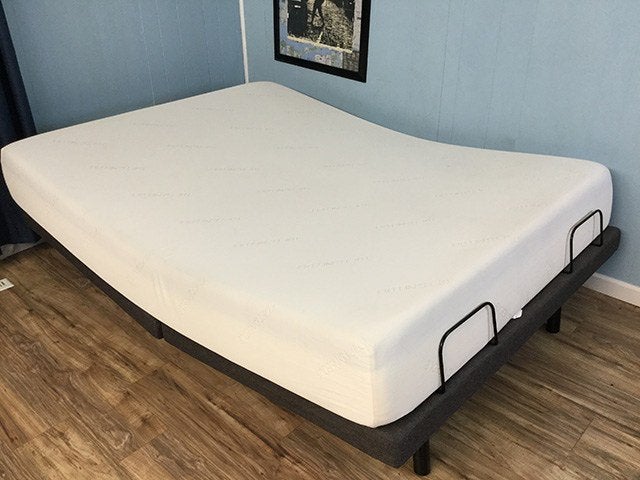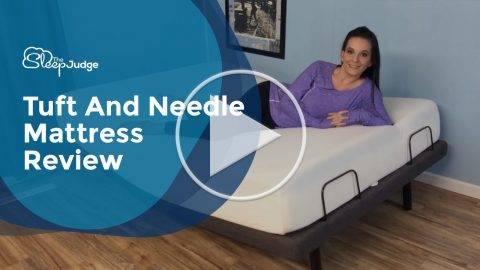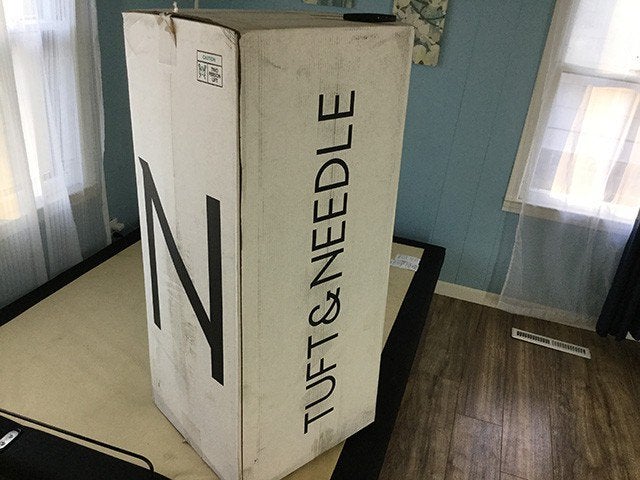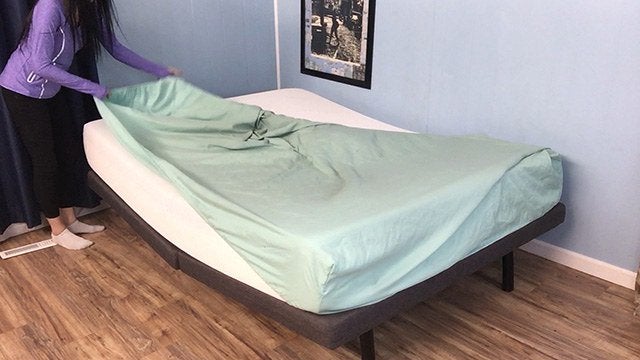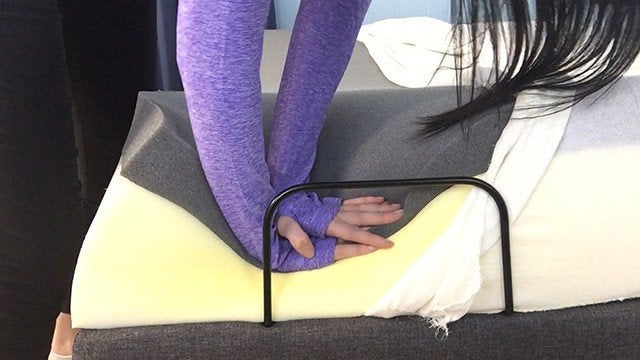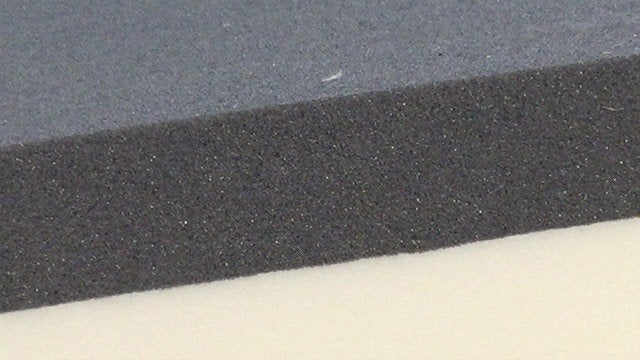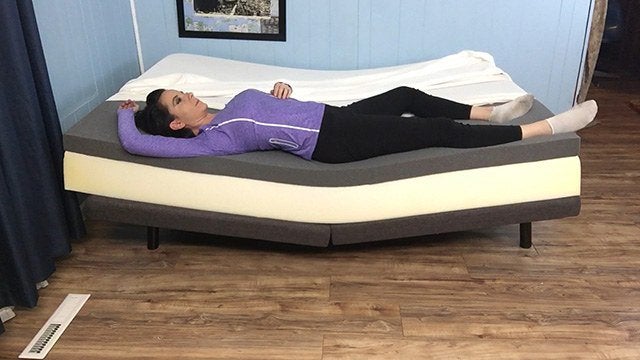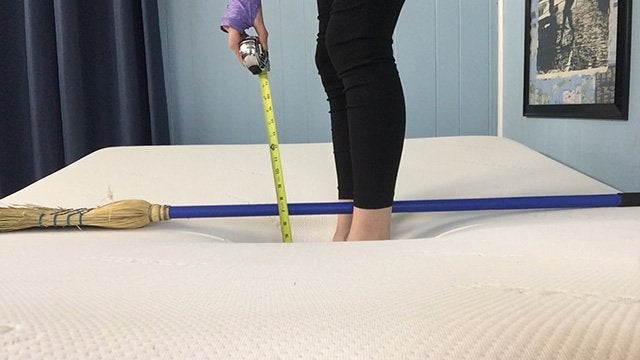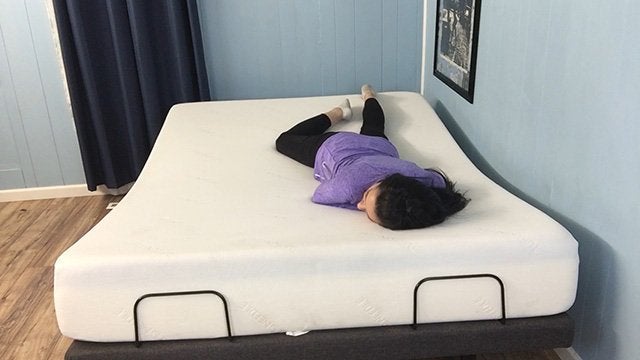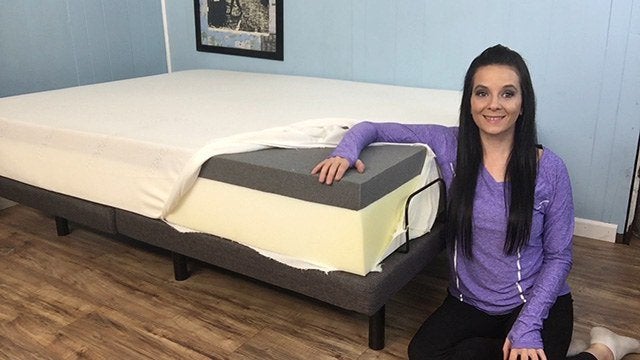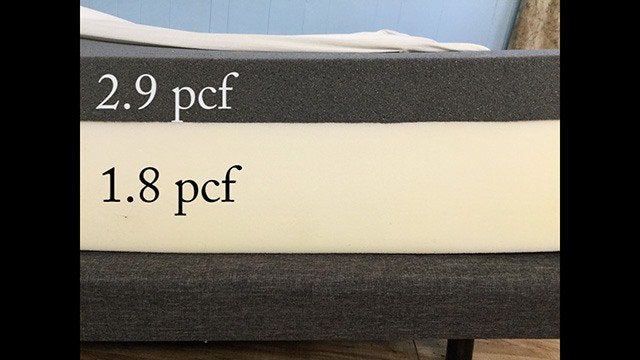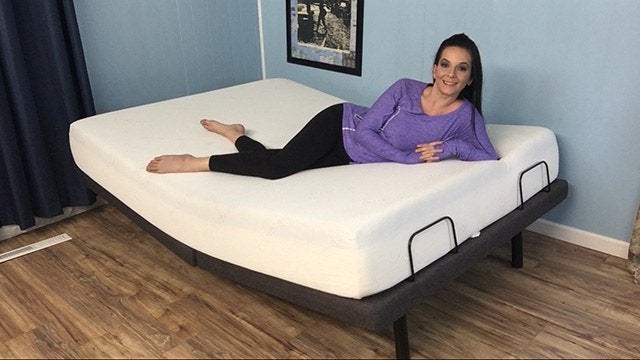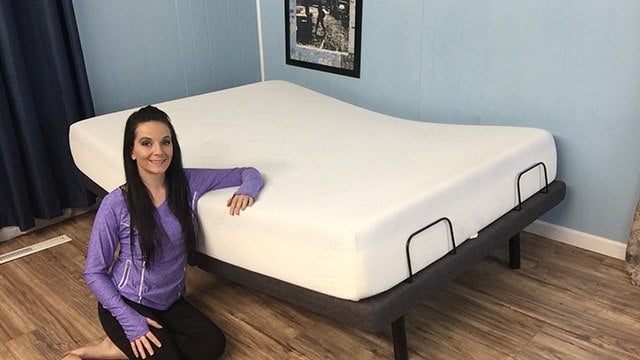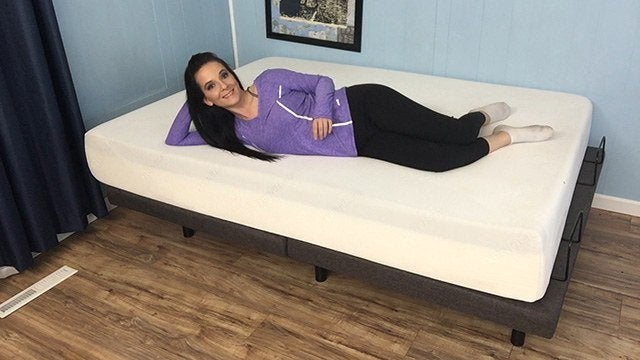The mattress shopping game has gone through a significant transformation in recent years. It’s great to have so many options at your fingertips, but how do you choose from the hundreds of options available?
Online mattress shopping can help you maximize efficiency and look at a broad spectrum of options. If you have a sleep partner and want something that will best accommodate the both of you and/or are on a budget but don’t want to sacrifice on quality, Tuft & Needle should be on your list of beds to consider. We took a look at the queen-size model, so keep reading to see what it has to offer.
Video Review
Don’t want to read the full review? Watch our video review instead.
You might want to read: Brooklyn Bedding Mattress vs Tuft & Needle Mattress
Tuft & Needle Mattress Specs Sheet
Offgassing – Cleared within 24 hours
Firmness Level (Scale of 1-10) – 5.0
Trial Period – 100 nights
Warranty – 10-Year Warranty
A Bit of Company Background
Tuft & Needle got involved in the online mattress industry early on in 2012, so they’ve had six years to play with their design to come up with one best-suited for any sleeping preference. Many online mattress companies add multiple layers, and they can work to highlight benefits and compensate weaknesses of one another. However, that doesn’t mean more is better.
During their years of research, Tuft & Needle chose to go with a two-layer construction that puts an increased focus on quality and works to accommodate the average sleeper. Let’s take a look at how it works.
1. Polyester/Tactel Cover
Tuft & Needle’s cover has been updated to make it even more plush and luxurious. It is made of a blend of polyester and Tactel. When you tug on it, you’ll find that it’s really stretchy and thin. This works to keep you comfortable in a couple different ways:
- Its thinness allows you to more effectively engage with the foam found in the comfort layer.
- It allows the mattress to breathe well to keep you cool. Since Tactel dries more quickly than cotton, this further aids in breathability.
If you don’t weigh a whole lot, you may struggle to get comfortable when you start placing sheets and mattress protectors on your bed. I really liked the way I could still feel the contouring support even with my protector in place, and this is partially due to the thin cover.
2. Tuft & Needle Two-Layer Construction
Directly under the cover, we find a three-inch layer of proprietary Tuft & Needle Adaptive® foam designed to offer effective pressure relief. The blend they’ve developed in this layer contains heat-wicking graphite and cooling gel to help keep you cool, and it makes up the entire comfort layer.
When you release pressure, you’ll find the material is quick to respond. This is helpful if you don’t like that extra sinkage you get with memory foams or struggle to get in and out of bed. It also aids those with mobility issues in moving around with ease.
Lastly, we arrive at the base layer. It’s seven inches thick and comprised of polyfoam. Tuft & Needle provides four reasons they arrived at this material combination over the years.
- The pushback from latex material can lead to painful pressure points.
- Memory foam can reduce mobility and sleep hot.
- Spring mattresses rely on a high degree of empty support.
- Convoluted foam is just a single piece of foam cut in half disguised to appear to offer more than it actually does.
You may be interested in: Tuft & Needle Pillow Review
Tuft & Needle Mattress Performance
With these considerations in mind, let’s talk about how this mattress actually feels to lay down on. In all three primary sleeping positions, I get good pressure relief in the proprietary comfort layer. I think it’s worth noting for side sleepers who carry a lot of weight that, since the mattress transitions directly from the comfort layer to the base, you may experience a harder firmness in heavier areas like the hips and shoulders. I’ve found a mattress topper to help in these situations.
I typically sleep on my back. Having recently recovered from a lower back injury, I was especially aware of the contour of the lumbar curvature. I think the product does a good job at catering to the average mattress shopper in terms of overall comfort and support at a very affordable cost for quality materials.
Firmness and Sinkage
Tuft & Needle is aimed at the average mattress shopper, and a medium firmness is what most companies shoot for to appeal to the masses. In the products I’ve tried out, I find that I typically sink 6 ½ inches when I stand in the middle of medium-firm products. This is exactly how much I sank on the Tuft & Needle, so this is reflective of medium firmness.
For a better visual representation of how the two layers work together to provide average firmness, check out our review video above. You’ll see that I do have to exert more pressure when I come to the base layer, and this also shows how the layers work together to provide comfort and support.
If you sleep on your stomach or carry a lot of weight, you may want to consider a product that offers a harder firmness option. However, for most sleepers, medium firmness is accommodating, making Tuft & Needle a fair compromise for sleep partners with varying preferences.
Motion Transfer Reduction
Sleep partners don’t want to forget to check out motion transfer reduction. This represents the mattress’ ability to isolate motion to the point of impact. In other words, if you move around, your partner isn’t as likely to be bothered.
In my experience, I was able to feel someone’s movements when they laid down next to me. You could also see my body move slightly when someone moved around next to me. However, the disruption was minimal. I was never woken up due to motion transfer.
We performed a test to demonstrate motion isolation, and you can check it out in our review video above. We dropped a 20-pound medicine ball next to a resting ball of the same weight. Again, there was a little bit of movement, but it is minimal. Considering there is no memory foam in this product, I think it did a pretty good job at keeping motion transfer low.
Heat Transfer Capabilities
As we made our way through the layers, we talked about how the thinness of the cover works with the heat-wicking graphite and cooling gel in the comfort layer to promote breathability.
To put it to the test, I laid on my Tuft & Needle for 30 minutes in a 64-degree Fahrenheit room temperature. Average cooldown time in my experience is right around 10 minutes, and Tuft & Needle took 11 minutes. This is pretty close to average, and I think this reflects the product’s goal in a construction that appeals to the majority of customers.
My son really took a liking to this mattress, and he is prone to kicking the covers off at night. He reported sleeping at a comfortable temperature as we tested this product. I was also able to maintain cool sleep. If you have significant issues with hot sleeping, you may want to look into a product with a high degree of focus in cooling features. However, for most customers, I think you’ll find Tuft & Needle to be adequately breathable.
Durability Expectations
In most cases, you get what you pay for. When you see a product that’s priced significantly less than its competition, you can usually expect a drop in quality. However, I was impressed with the densities you find at each layer of the Tuft & Needle mattress.
Significance of Density
Density in the mattress industry describes the weight of a 12-inch square cube of the material being analyzed. In polyfoam, which is what we find at each layer of this product, you want that weight to be no less than 1.8 pounds. If you weigh more than 250 pounds, I’d suggest shooting for no less than two pounds per cubic foot in the comfort layer, which is where most wear and tear takes place.
Take a look at the densities in Tuft & Needle. In the top, we find a density of an impressive 2.9 pcf, and this is where you really need it. In the support layer, the density is 1.8, and this is perfectly acceptable in terms of durability at this level. Overall, with normal use, this mattress can easily offer seven to 10 years of consistent comfort and support.
You may be interested in: Casper vs Tuft & Needle
Edge Support
The level of support you find at the edge of your mattress is an often overlooked feature. When the right amount of support isn’t there, it can be difficult to get in and out of bed, and falling out of bed becomes a bigger risk if you sleep close to the edge.
In mattresses made entirely of foam like Tuft & Needle, we often find a lack of edge support, but you can see here that the base does a good job keeping me supported. You can feel yourself sink into the comfort layer while also detecting the point where the support layer kicks in and adds that upward lift.
If you have a sleep partner, you probably lay on the edge from time to time. I feel equally supported across my entire body. For an all-foam product, Tuft & Needle has pretty good edge support. If you have severe mobility problems, you may consider checking out products that feature an innerspring unit.
Maintenance, Protection, Care and Warranty
One of the most impressive aspects of Tuft & Needle is the price. This product contains high-quality materials when it comes to durability expectations. When sized up with other products in the online market of comparable material composition, you can save as much as 40 percent. This makes it a great solution for anyone on a budget who doesn’t want to compromise when it comes to quality.
Think this sounds like it could be a good choice for you? If so, check out the FAQs section for few details that are easy to forget until you run into a problem.
You may be interested in: Best Box Spring From Tuft & Needle Review
Tuft And Needle Reviews and Feedback
In just two layers, Tuft & Needle has succeeded in producing a product that is:
- Easy on the budget
- Highly-durable
- Able to accommodate the average person
Some of the information shared here is supported by my own personal opinion, and various body types will experience aspects like firmness and edge support differently. I took a moment to see what other customers had to say to ensure a well-rounded understanding of what you’re getting with Tuft & Needle:
Pros
- Excellent cost to quality ratio
- Product stays cool
- Built to last
Cons
- Some complaints of mattress being too plush for those carrying more weight
- Some complaints of off-gassing
- Some complaints of pressure points in heavier areas when side-sleeping due to the immediate transition from comfort to support layer.
You may want to read: Tuft & Needle Mint Unboxing
Who We Recommend the Tuft & Needle Mattress For
If you’re still not quite sure if Tuft & Needle is the one, let’s take a moment to review the main features of this mattress. This product could be for you if:
- You have a sleep partner and want to find something that’s geared toward accommodating the average person.
- You’re on a budget but don’t want to compromise on quality.
- You appreciate working with a company with plenty of experience in the online mattress industry.
You may be interested in: Tuft & Needle Mint Mattress Review
Our Final Verdict
I think Tuft & Needle is a great consideration for sleep partners, especially if they have varying preferences and are looking for a product designed for the average person. Tuft & Needle offers a 100-night sleep trial and a 10-year warranty. If you’re not happy with yours for any reason during the first 100 nights, you can return it for a full refund, but 95% of their customers choose to keep theirs. Their foams maintain various certifications including GreenGuard Gold, CertiPUR-US, and OEKO-TEX, so it’s safe for anyone to use including those with allergies and young children.
You may be interested in: Nectar Vs. Tuft & Needle, Which Is Better
Tuft & Needle Mattress Specs Sheet
| Material | Thickness | ILD | Density |
|---|---|---|---|
| Tuft & Needle Adaptive® foam | 3 inches | n/a | 2.9 lbs. |
| Polyfoam base | 7 inches | n/a | 1.8 lbs. |
Frequently Asked Questions
Is a Mattress Pad or Protector Needed?
I always suggest you consider a quality mattress protector. They go a long way in preserving your mattress and keeping the cover clean. However, you don’t have to use one.
Does it Work on Adjustable Beds?
Yes.
Are Returns Hassle-Free?
100% full refund during sleep trial.
What’s the Warranty?
10-Year Warranty.
Is There A Trial Available?
Yes. 100 nights.
Does It Need To Be Rotated?
No.
